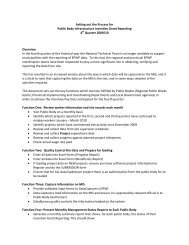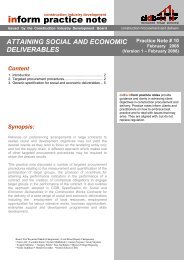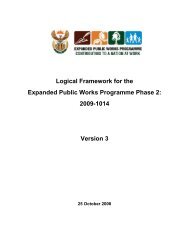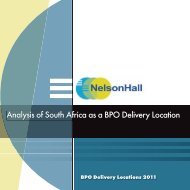Evaluation of the Monyetla Work Readiness ... - Business Trust
Evaluation of the Monyetla Work Readiness ... - Business Trust
Evaluation of the Monyetla Work Readiness ... - Business Trust
You also want an ePaper? Increase the reach of your titles
YUMPU automatically turns print PDFs into web optimized ePapers that Google loves.
4.3.7 Placement RatesA key requirement <strong>of</strong> <strong>the</strong> <strong>Monyetla</strong> programme stemming from objective 3 <strong>of</strong> <strong>the</strong> RFP was:• To ensure <strong>the</strong> placement <strong>of</strong> 70% <strong>of</strong> learners in employment on completion <strong>of</strong> <strong>the</strong> skills programme.Consultations with employers confirmed <strong>the</strong> need for entry-level talent and a willingness to absorbproperly trained entrants into <strong>the</strong> workplace. The <strong>Monyetla</strong> programme is designed to support arapidly expanding sector which, among o<strong>the</strong>r things, will benefit from enhanced governmentassistance and an expanded international marketing drive.Placement rates for consortia that had completed <strong>the</strong> project and closed out ranged from 70% to100%, well within <strong>the</strong> placement target with only one consortia not being able to achieve <strong>the</strong> 70%and managing to place 60.5% <strong>of</strong> its learners. At <strong>the</strong> time <strong>of</strong> writing <strong>the</strong> overall employment figurestands at 89.99%, which is 19.99% above <strong>the</strong> minimum percentage required.Table 11 shows that 41% <strong>of</strong> consortia managed to post a 100% placement rate. It also reveals that all<strong>the</strong>se consortia were led by employers, 71% were led by host employers and <strong>the</strong> remaining 29% bylead employers. From this we can conclude that employer-led consortia enjoyed <strong>the</strong> highestplacement rates with consortia that had host employers performing better than those with leademployers.One consortium that also managed to place 100% <strong>of</strong> its learners was led by a project manager.What Table 11 also shows is <strong>the</strong> important role that training providers play as lead members,particularly from a project management and administration perspective, whereby all <strong>the</strong> consortiathat achieved more than 80% placement rates had training providers assuming a project managementand administration role:• One hundred percent <strong>of</strong> consortia that placed over 80% <strong>of</strong> learners had training providersplaying a project management and administrative role.The significance <strong>of</strong> training providers playing a lead role from an administrative and projectmanagement perspective was raised by 56% <strong>of</strong> training providers and 27% <strong>of</strong> <strong>the</strong> employers invarious statements:i. “Training providers have <strong>the</strong> most to lose (financially) if <strong>the</strong> learnership is not a success”ii. “Training providers should be playing an administrative and project management role as thisis <strong>the</strong>ir core competence and not <strong>of</strong> employers, whose main worry is to find good workersto enhance business productivity”.It was found that in most instances, training providers initiated <strong>the</strong> consortium’s approach to o<strong>the</strong>rparties, mainly because <strong>of</strong> <strong>the</strong> attractive training fee/grant/subsidy. In a number <strong>of</strong> instances, <strong>the</strong>training providers were instrumental in convincing employers to participate in <strong>the</strong> project based onthree value propositions;• “Participation in <strong>the</strong> programme as a social responsibility initiative”• “A fresh, passionate and motivated labour pool , comprised <strong>of</strong> people who have been putthrough an accredited skills programme and exposed to <strong>the</strong> company’s way <strong>of</strong> doingbusiness”• “To meet <strong>the</strong> expanding demand for trained call centre agents.”While <strong>the</strong> <strong>Monyetla</strong> programme was designed to be employer led and formulated to ensure thatemployers were in <strong>the</strong> driver’s seat and that placement objectives were met, evidence points totraining providers managing and administrating consortia internally to achieve programme objectives.Training providers were also <strong>the</strong> prime recipients <strong>of</strong> <strong>the</strong> learnership grant and would have had aprimary interest in ensuring placement to guarantee <strong>the</strong> payout <strong>of</strong> second tranches.42
















